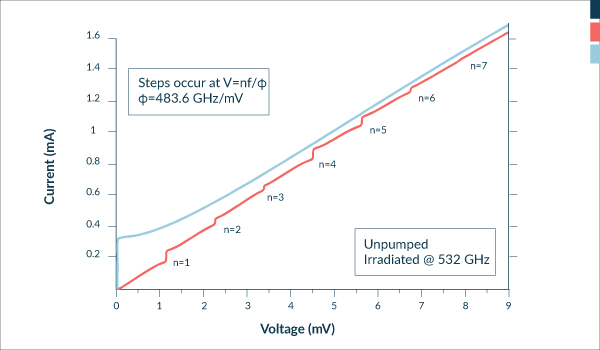Above:
Scanning Electron Microscope (SEM) image of an MgB2 Josephson mixer fabricated using a He+ ion beam. The raised spiral is the gold antenna for frequencies from ~200 GHz to 5 THz. There is an ultra-thin superconducting MgB2 bridge across the center of the spiral and the narrow line through the bridge is the He+ ion beam irradiation creating a weak-link Josephson Junction across this line.
High T Mixers
Warm Superconductor Detectors
Daniel Cunnane - Boris Karasik - Frank Greer
Magnesium diboride (MgB2) is a simple metallic compound discovered in 2001 to be superconducting. Ultrathin films (5-20 nm) of MgB2 with characteristics similar to those in the bulk have been achieved. The moderate critical temperature around 40 Kelvin (K) and large superconducting gap are very useful for high-frequency (THz) superconducting electronics with space applications.
The primary NASA/JPL application for these films is in THz mixers (hot-electron bolometers and Josephson junctions) for astrophysics. Proof-of-concept demonstrations of such mixers have recently been made in the 1-5 THz range. Operation at temperatures of 15-20K with high sensitivity and an intermediate frequency bandwidth nearly three times larger than the state-of-the-art (> 7 GHz) are important benefits of the MgB2 material. These devices were developed at MDL in collaboration with Temple University who synthesizes the superconducting thin films.
Researchers are currently working to develop waveguide-based mixer devices on silicon membranes in order to enable multi-pixel heterodyne receivers for future instrument concepts including the Heterodyne Receiver for the Origins Space Telescope (HERO). Other emerging applications include mid-infrared heterodyne detectors, optical single-photon detectors, phased antenna arrays, frequency multipliers, and parametric amplifiers. Josephson junction mixers are expected to enable large heterodyne arrays at 1.9 THz for mapping of neutral carbon spectral lines in the galaxy.
These mixers take advantage of the large gap in MgB2 or YBCO (critical temperature ~90 K) to use the AC Josephson effect as the mixing mechanism. The junctions are fabricated using a focused beam of Helium ions to directly write ~1 nanometer-wide barrier into the superconducting bridges. The novel technique is done at the University of California Riverside. The nanoscale junctions require less local oscillating power than other mixers, enabling much larger arrays.
Additional research has been started recently to develop the thin films in house using an atomic layer deposition system to emulate the process used at Temple University. The aim of that task is to develop large scale depositions (> 3”) on silicon substrates for fast throughput processing. Large area film with improved uniformity will allow application of advanced projection lithography in order to achieve submicron-size MgB2 devices with good yield. NASA’s Nancy Grace Roman Fellowship in Astrophysics funds this research at JPL.
The IV characteristic of a YBCO Josephson mixer without (black) and with (blue) 532 GHz local oscillator irradiation. The steps are created at constant voltages by the AC Josephson Effect, where superconducting electron pairs oscillating at harmonics of the fundamental 532 GHz. The 7 steps imply that the junction could potentially mix above 4 THz.
+ Larger image



